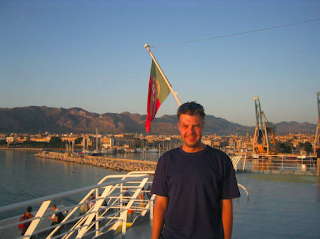Still the grandest complex of Doric temples outside Athens, Paestum had been a 6th century B.C. Greek colony, famed in antiquity for roses and violets.


American
ambulances parking by the temples of Neptune and Ceres as U.S.
infantrymen push past the centre of the American sector during the
landings around Salerno Bay.
On
September 9, 1943, Paestum was the location of the landing beaches of
the U.S. 36th Infantry Division during the Allied invasion of Italy.
German forces resisted the landings from the outset, causing heavy
fighting within and around the town. Combat persisted around the town
for nine days before the Germans withdrew to the north. The Allied
forces set up their Red Cross first aid tents in and around the temples
since the Temples were "off limits" to bombing by both sides.



The first Temple of Hera, built around 600 BC by Greek colonists, is the oldest surviving temple in Paestum. Eighteenth-century archaeologists named it "The Basilica" because they mistakenly believed it to be a Roman building. A basilica in Roman times was a civil building, not a religious one. Inscriptions revealed that the goddess worshipped here was Hera. Later, an altar was unearthed in front of the temple, in the open-air site usual for a Greek altar; the faithful could attend rites and sacrifices without entering the cella.


On
the highest point of the town, some way from the other temples, is the
Temple of Athena. It was built around 500 BC, and was for some time
incorrectly thought to have been dedicated to Ceres. The architecture is
transitional, being partly in the Ionic style and partly early Doric.
On
the sacred way between the Justice Gate and Golden Gate to the north
which had been destroyed in 1828 the road was built through the
excavations.
 The
so-called hypogean (underground) shrine found in 1954. Appearing as a
small inaccessible underground room with a roof made of plain tiles and
an altar on the steps at the front, inside was found eight bronze vases
containing honey, a black-figure amphora depicting the apotheosis of
Heracles, and five iron skewers on two stone blocks. The small monument
located at the western end of the agora, was originally placed under a
mound making it not visible. It was later bordered by a quadrangular
enclosure in blocks and dated to 520-510 BCE to represent an heroon- a
cenotaph in honour of the hero-founder of the city. It was assumed that
it commemorated Is, the mythical founder of Sybaris, led to Paestum by
sybaritic refugees. The assumption that it is an underground chapel for
worship of the nymphs - a result of the discovery of a ceramic fragment
with its graffiti - is now discredited.
The
so-called hypogean (underground) shrine found in 1954. Appearing as a
small inaccessible underground room with a roof made of plain tiles and
an altar on the steps at the front, inside was found eight bronze vases
containing honey, a black-figure amphora depicting the apotheosis of
Heracles, and five iron skewers on two stone blocks. The small monument
located at the western end of the agora, was originally placed under a
mound making it not visible. It was later bordered by a quadrangular
enclosure in blocks and dated to 520-510 BCE to represent an heroon- a
cenotaph in honour of the hero-founder of the city. It was assumed that
it commemorated Is, the mythical founder of Sybaris, led to Paestum by
sybaritic refugees. The assumption that it is an underground chapel for
worship of the nymphs - a result of the discovery of a ceramic fragment
with its graffiti - is now discredited. 



Beside
Greek houses- that on the left with its large area of tessellated
pavement which has been preserved and that on that on the right which
had a swimming pool forming part of the peristyle; the temple of Athena
can be seen in the background.



Paestum is also renowned for its painted tombs, mainly belonging to the period of the Lucanian rule, while only one of them dates to the Greek period. It was found, on 3 June 1968, in a small necropolis some 1.5 km south of the ancient walls. The burial monument was named Tomb of the Diver after the enigmatic scene, depicted on the covering slab directly behind me, of a lonely young man diving into a stream of water. It was dated to about 470 BCE, the Golden Age of the Greek town. The tomb is painted with the true fresco technique and its importance lies in being "the only example of Greek painting with figured scenes dating from the Orientalising, Archaic, or Classical periods to survive in its entirety. Among the thousands of Greek tombs known from roughly 700–400 BCE, this is the only one to have been decorated with frescoes of human subjects." The symposium on the north wall. The remaining four walls of the tombs are occupied by symposium related scenes, an iconography far more familiar from the Greek pottery than the diving scene. All the five frescoes are visible in the local National Museum, together with the cycle of Lucanian painted tombs.


The National Archaeological Museum in Naples in 1895 and today
Inside
then and now; the exhibits in markedly third-class surroundings today.
This marble statue of Athena Promachos ("Athena who fights in the front
line") was found at the Villa of the Papyri in Herculaneum.
























